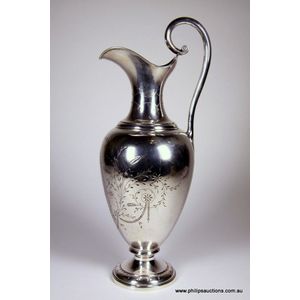Hannah Barlow Doulton Lambeth Stoneware Ewers with Cat Decoration
You must be a subscriber, and be logged in to view price and dealer details.
Subscribe Now to view actual auction price for this item
When you subscribe, you have the option of setting the currency in which to display prices to $Au, $US, $NZ or Stg.
- A/f, as Inspected - The letters "A/F" or "as inspected" as part of a description is the cataloguer's shorthand for "all faults" or "as found", meaning the item has some type of damage or deficiency, it is of uncertain date or provenance, and/or that the seller takes no responsibility for the completeness of the item or the accuracy of the description.
- Incised - A record of a name, date or inscription, or a decoration scratched into a surface, usually of a glass or ceramic item with a blunt instrument to make a coarse indentation. Compare with engraving where the surface is cut with a sharp instrument such as a metal needle or rotating tool to achieve a fine indentation.
- Circa - A Latin term meaning 'about', often used in the antique trade to give an approximate date for the piece, usually considered to be five years on either side of the circa year. Thus, circa 1900 means the piece was made about 1900, probably between 1895 and 1905. The expression is sometimes abbreviated to c.1900.
- Ewer / Pitcher - A type of jug with a narrow neck bulbous body and wide spout, originally used for carrying and storing liquids such as water or wine. In medieval times they were the source of water to wash ones hands during and after a meal. later the shape was used for vessels in silver, gold, glass and ceramics.
In Victorian times they were made in ceramics and occasionally glass with a matching basin, and sometimes other accessories such as a soap holder or toothbrush holder. Their purpose was to provide facilities for personal washing In the early 19th century were often enclosed in purpose built stands, and later resided on a washstand..
Sometimes the words "ewer" and "pitcher" are used interchangably, but a pitcher is generally considered to be a jug, and would have a wide mouth, and a gently tapering body.
This item has been included into following indexes:
- Barlow, Hannah (England) - Royal Doulton, designers 60
-
Royal Doulton (England), item types
- jugs, other 517
- Lambeth Ware, jugs 98
- stoneware, other items 148
Visually similar items

A Victorian Grecian style sterling silver wine ewer, 1853 London, with maker's mark for Joseph and Albert Savory, the neoclassical style ewer with a baluster body and a slender waisted neck surmounted by an unusual looped pouring spout having an exaggerate

A fine Danish .826 silver wine ewer, circa 1888 with three towers mark, maker's mark of Peter Hertz, assay master mark of Simon Groth, of elegant baluster form with a waisted collar and shaped pouring rim, a high set scrolling handle and a pedestal base, d

An Edwardian Royal Worcester rose painted urn form specimen vase by Blake, the leaf scroll and mask handles elaborately gilded, finely rose painted front and back. Printed mark dated coded 1908 and shape #1683. Height 18.5 cm.

Royal china works blush ivory hand painted urn with floral motifs and a pierced spout, marked with green stamp 'Royal china works Worcester established 1801' 965/G6046. Height 16.5 cm
